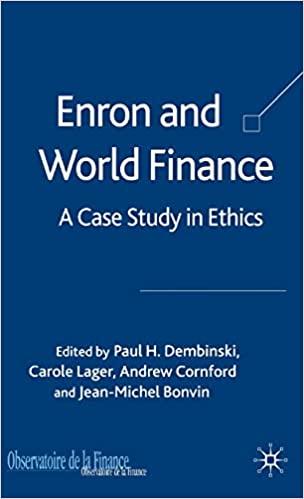Question
Suppose Patrick has accumulated $10,000 in credit card debt. He decides to stop spending immediately, and pay P per month required until his debt is
Suppose Patrick has accumulated $10,000 in credit card debt. He decides to stop spending immediately, and pay P per month required until his debt is paid off. His credit card charges an annual interest rate of 18%, compounded monthly. We will answer the following questions: how long will it take him to pay off his debt and how much will he pay under different values of P? To get started, we first figure out the amount owed after the first few months:
Month 1: The amount owed is $10000 and P is repaid. The remaining balance is thus 10000 P. This is the amount to which interest will be applied, so at the end of the first month (i.e. before the payment of P is made at the beginning of the second month,
(10000-P)x(1+(.18/12))=1.015(10000)-1.015P
is owed. Thus, the amount that Patrick owes after the payment is made at the start of month 2 is:
10000(1.015) [P + 1.015P]
Month 2: The amount owed at the end of the second month is 1.015(10000) [P + 1.015P]. This is the amount to which the interest will be applied. After the second month (before the payment is made at the start of month 3), the amount owed is:
[(1.015)10000 (P + 1.015P)] 1.015 = 10000(1.015)2 [P(1.015) + P(1.015)2]
is owed. Thus, the amount that Patrick owes after the payment is made at the start of month 3 is:
10000(1.015)2 [P + 1.015P + (1.015)2P]
By applying the same logic as above:
A) Repeat the logic above to calculate the amount owed after Patrick makes the payment after the start of Month 4.
B) Hopefully, the pattern is clear! Call the amount owed after the payment at the start of Month n An. Based off of this pattern, write down a formula for An. Then, using the geometric sum formula developed in Problem 5, show that the sum can be expressed as:
An = 10000(1.015)n1 (200/3) P [(1.015)n 1] .
The Result above can be interpreted as follows:
After the payment at the beginning of Month n is made, the Debt of $10,000 have grown to:
D = 10000(1.015)n1
This is equivalent to applying the compound interest formula to the original debt if one notes that at the start of Month n, interest has been applied to the debt n 1 times (since interest is applied at the end of the previous month).
After the payment at the beginning of Month n is made, the future value of the amount he will have Repaid will be:
R = (200/3) P [(1.015)n 1]
C) If P = $100, will Patrick ever get out of debt? Justify your response!
D) For both P = $200, and P = $500 answer both:
i. How long will it take for Patrick to get out of debt?
ii. How much will he have to pay his credit card company?
To answer ii. note that if you get a fraction of a month, the amount owed at the beginning of the final month will be less than P! You should calculate the amount owed at the end of the month before Patrick makes the payment at the start of Month n. His payment for Month n will just be the remaining balance!
Step by Step Solution
There are 3 Steps involved in it
Step: 1

Get Instant Access to Expert-Tailored Solutions
See step-by-step solutions with expert insights and AI powered tools for academic success
Step: 2

Step: 3

Ace Your Homework with AI
Get the answers you need in no time with our AI-driven, step-by-step assistance
Get Started


